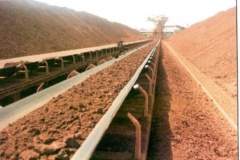Bauxite
| Infobox on Bauxite | |
|---|---|
| Example of Bauxite |  |
| Facts | |
| Origin | - |
| Stowage factor (in m3/t) | 0,85/0,93 m3/t (bulk) |
| Humidity / moisture | - |
| Ventilation | - |
| Risk factors | See text |
Bauxite
Description / Application
A brownish - yellow clay-like / earthy mineral, it consists mainly of hydrated alumina, mixed with silica and iron hydroxide and is the most important source of aluminum.
It is also known as aluminium ore and usually obtained from open cast mines.
Bauxite is usually strip mined because it is almost always found near the surface of the terrain, with little or no overburden. Approximately 70% to 80% of the world's dry bauxite production is processed first into alumina, and then into aluminium by electrolysis as of 2010. Bauxite rocks are typically classified according to their intended commercial application: metallurgical, abrasive, cement, chemical, and refractory.
Despite being present in such incredibly vast quantities on Earth, the metal never occurs on it's own in nature. Instead of existing free like Gold and Silver, due to its higher level of reactivity, it is always chemically bonded in compounds when it normally occurs. The most common of these compounds is Bauxite, or Aluminium Ore which contains large quantities of Aluminium Oxide. Typically this is a combination of Aluminium and Oxygen in the formula Al2O3.2H2O. There are also the impurities Fe2O3 and SiO2, amongst others, present in Bauxite, which have to be removed in the Bayer Process in the production of pure aluminium.
Usually, bauxite ore is heated in a pressure vessel along with a Sodium Hydroxide solution at a temperature of 150 to 200°C. At these temperatures, the aluminium is dissolved as an aluminate (the Bayer process). After separation of ferruginous residue (red mud) by filtering, pure gibbsite is precipitated when the liquid is cooled, and then seeded with fine-grained aluminium hydroxide. The gibbsite is usually converted into Aluminium Oxide, Al2O3, by heating. This mineral becomes molten at a temperature of about 1000°C, when the mineral cryolite is added as a flux. Next, this molten substance can yield metallic aluminium by passing an electric current through it in the process of electrolysis, which is called the Hall–Héroult process after its American and French discoverers in 1886.
Bauxite reserves are spread across the world. Large deposits include: Australia, Brazil, Guinea and Jamaica. Around 85% of all Bauxite mined from the Earth is used to produce aluminium metal, which goes on to be used for a huge variety of uses. The remaining 15% goes towards chemical and refractory materials, along with making aluminium compounds.
Shipment / Storage
If loaded in moist condition, cargo has to be properly covered with plastic foil. Do not load delicate cargo on top nor rubber because of mould damage.
Containers to be loaded shall be thoroughly cleaned. Other cargo must be protected against dust damage during stuffing/unstuffing.
Risk factors
Reference is made to the relevant IMO publications of hazardous cargo.











